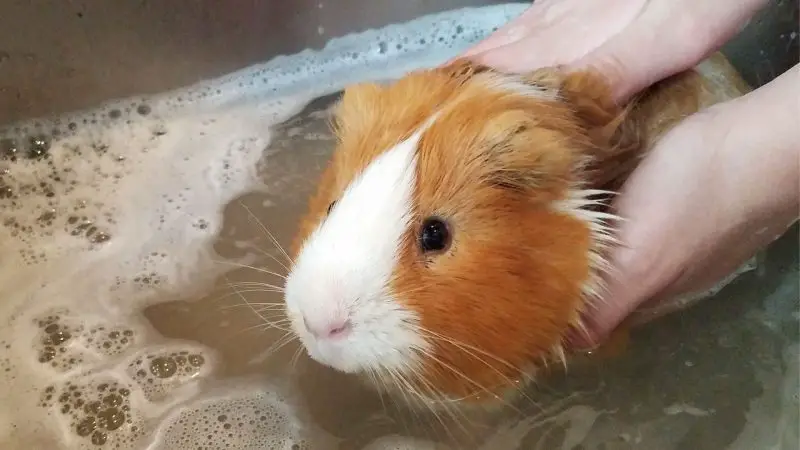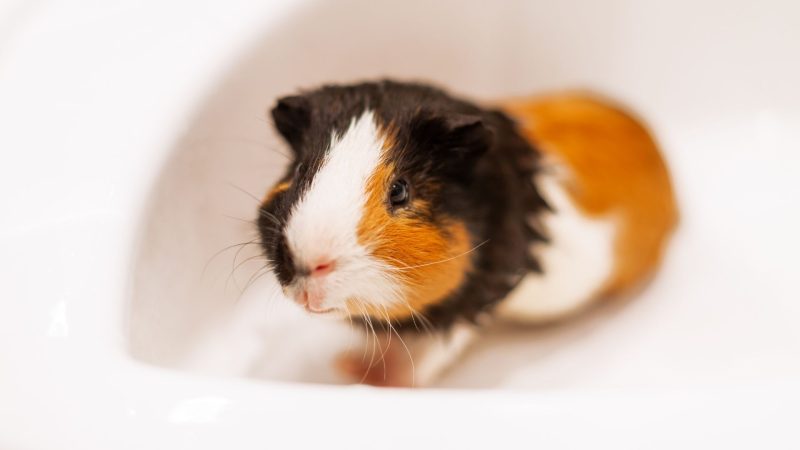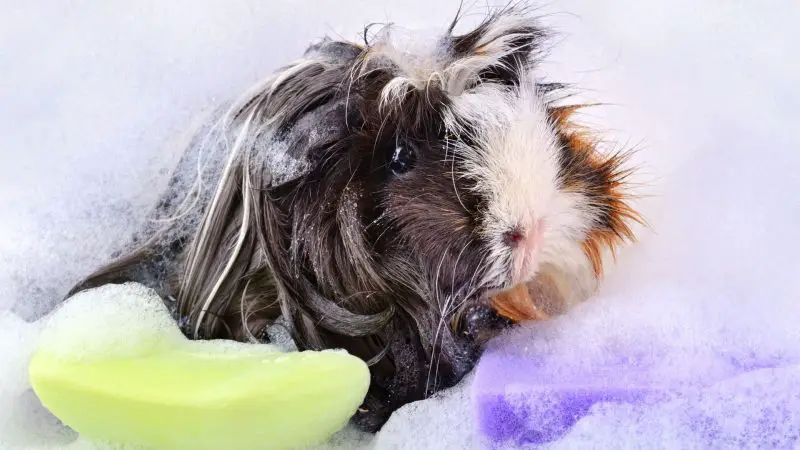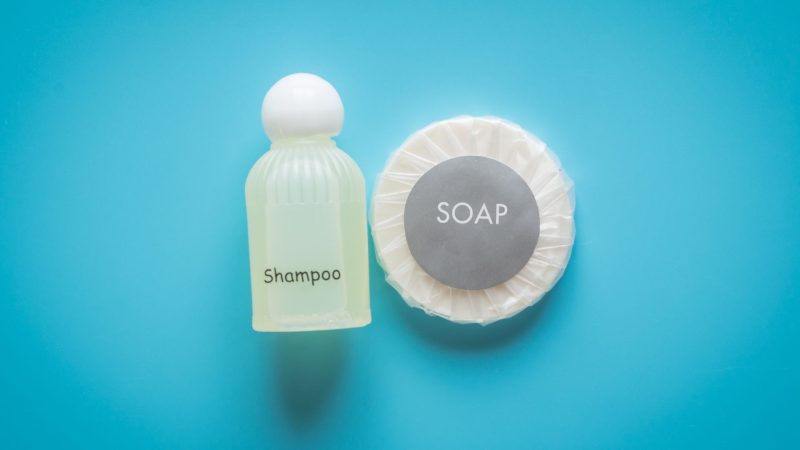Keeping a pet is enjoyable, but it comes with certain obligations. The pet is happy with feeding, housing, bedding, playtime, and similar things.
But hygiene is the factor neglected by most pet owners, and sometimes it is even overdone. So as the owner, you must know when to give a bath and how.
How to give guinea pigs a bath? To bathe guinea pigs, gently transfer them to a sink or bathtub with warm water around 1.5 to 2 inches deep. Pour the water into their body, lather their fur with pet’s shampoo, avoid their eyes, nose, and mouth, and rinse them after. Wrap them with a dry towel, dampen their face, and dry their coat. Also, you can dry their fur using blow dyer set to coolest temperature. Finally, comb their fur and return them to their clean cage.
This article will give you tips and tricks for the hygiene of your guinea pig, whether bathing should be done often or rarely, how bathing affects the health of the cavy, or even which cosmetics are suitable for its fur.
Table of Content
Do Guinea Pigs Need Baths and How Often?

Guinea pigs always clean themselves by licking their own fur. But, some illnesses may require bathing often, and in other cases, the cavies must also be bathed if their long furs are oily, soiled, or too dirty.
In general, it is risky to bathe rodents, especially often. As a rule of thumb, if you like to keep your rodent pet clean, once a month is enough for baths. Some owners bathe the cavies more in the summer and rarely in winter.
It can be more often, but only when the veterinarian recommends frequent baths such as removing parasites from the fur or for a similar reason.
If cavies are bathed too often or more than once per month, they get more prone to skin infections and can get cold often as well.
When Do Guinea Pigs Need a Bath and When They Don’t Need One?

When a guinea pig needs a bath, it can be due to several reasons:
- The coat is long, and the cavy has many furs that need combing or maintenance. This type of fur gets greasier more often and dirtier. So, most likely, long-hair guinea pigs would probably make use of baths more than other breeds.
- You intend to show the guinea pig on exhibits for pets or similar appearances. It is justified to give the cavy a proper bath in this case.
- The veterinarian recommended baths for removing certain issues, like a parasite or fungal infection of the cavy’s skin and fur.
- Once parasite infection is removed, regular baths to take good care of the skin and fur of the cavy should be advised, ensuring parasites won’t come back.
When the guinea pig doesn’t need a bath, it is for these reasons:
- It suffers from a respiratory infection or illness.
- The cavy is quite sick, nauseous, or has some obvious health problem that seeks medical attention.
- You keep the guinea pig in outdoor spaces, like a balcony, yard, patio – especially in the fall and winter times!
How to Bathe the Guinea Pig Properly?

You need to remember that guinea pigs do not need excessive bathing, especially since they bathe themselves, similar to cats licking their own fur. A clean cage for the cavy is the first and biggest step for their hygiene – this means less bathing times if the cage and bedding are clean.
Things You Need to Bathe Your Guinea Pigs
Here are the things you need before bathing guinea pigs:
- Guinea pig’s shampoo or mild and all-organic soap good for pets
- Pouring cup
- 2 Towels (a small and large one)
- Sink or bathtub
- Warm water
- Blow dryer (optional)
Steps to Bathing Guinea Pigs
Here are the steps to follow:
Step 1: Set everything and prepare all the above-mentioned items.
Step 2: Fill the tub with warm water, around 1.5 to 2 inches deep, depending on the size of your guinea pig.
Note: Bathtub is much better because the cavy cannot climb upwards or try to escape.
Step 3: Take the guinea pig and slowly introduce it to the water. You can lay it down as you hold it gently. Adjust your grasp according to the cavy’s reaction to the water, and let it adjust to this new wet and different environment.
Step 4: With the cup, slowly pour a bit of the water on the guinea pig close to its body and back, not its head and eyes. Lather the fur and coat of the cavy gently, avoiding the eyes, nose, and mouth.
Step 5: Using a pouring cup, gently rinse the foam on its body with warm water. You can repeat it two to three times to ensure no foam is left. Also, you can even keep a few bites of food or treats nearby to calm down the cavy if it’s a bit disturbed or fidgety after you rinse it.
Step 6: Gently take the cavy in your arms, wrap it gently in a dry towel and try to clean its face by slowly wiping it with another towel. When you wipe the face of the guinea pig, dampen the towel slightly for better results.
Then, with the dry towel, pat the fur of the cavy well until the moist is almost gone. When the cavy is fully dry, comb it a bit and return it to its cage.
Note: You can use a blow dryer set to a cool temperature and lowest speed to dry the fur and coat of your guinea pig while brushing them.
Remember, after bath time, you have to return the cavy in a clean cage, with clean bedding and fresh food and water.
Can Human Body-Care Products Be Used for Bathing a Guinea Pig?

Products used by humans for bathing and washing hair are definitely not good for guinea pigs. Our skin, scalp, and hair are different than the cavy’s, so suitable cosmetics must be used.
Some products specially designed for guinea pigs are quite pricey, as most are made for pets. You can choose between shampoos for guinea pigs, or a more economical option is a soap made out of all-natural ingredients and almost no scents – if possible, no scent, all-organic and natural.
Also, you can find such items in specialized pet stores, supermarkets, or even pharmacies and stores online. Organic supermarkets or shops are a good option too if you have them nearby where you live.
But there is another risk with soaps as well – if they are not tested on animals, you won’t know if they are good for the cavy. So try to find a product that does not promote animal cruelty nor is harmful to the cavy’s fur.
As a guideline, such soaps can be made of goat milk and some oils, like vegetable oils. Even though they are not tested on animals, their ingredients should be good enough for humans and guinea pigs.
Can Baby Shampoo Be Used in Guinea Pig Bath?
Often, owners mistakenly use baby shampoos, thinking that if the baby’s hair benefits from such a shampoo, it must be good for the guinea pig’s hair as well. However, this is not good for guinea pigs, as it is not made for pets.
Can Guinea Pigs Swim During Bath Time?
Guinea pigs are completely capable of swimming, having a survival instinct out of their natural environment.
In general, guinea pigs dislike being bathed, but rarely, when relaxed and not stressed, you can see them enjoying the warm water briefly. Think of cavies as cats; they dislike wet environments and prefer to clean by themselves whenever possible.
If the cavy is stressed, it will be fidgety and move around in the water, avoiding the bath. But if it’s relaxed and even tries to stay calm or swim a little bit, it is a good sign. Overall, they do not like to swim, and they don’t love being in the water, so try to make bath time extra relaxed for them.
The Rules for Proper Grooming of the Guinea Pig:
- Purchase organic soaps or special shampoos for guinea pigs.
- Lather shortly and rinse well.
- Dry the cavy with a warm, dry towel.
- Avoid water and foam on their face or eyes.
- Bathe them just once per month.
- Check their eyes, ears, mouth, nose; look for discharge or any outer changes.
- Check the feet and nails; look for red patches, soreness, and look for nail changes.
- Check the rear end and rinse it with lukewarm water to avoid illnesses from feces remains.
- Offer snacks and treats right after bath time – surprise the cavy with fruits or veggies it loves!
Bathe your pets once a month, dry them well, gently brush their fur, offer snacks and treats that will make their bath time as enjoyable and relaxed as possible – you will have a happy, healthy, and clean cavy!
Related: Can Guinea Pigs Swim in a Bathtub? | All You Need to Know!
